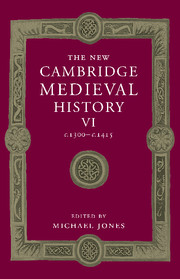Book contents
- Frontmatter
- Part I General Themes
- 1 Introduction
- 2 The Theory and Practice of Government in Western Europe in the Fourteenth Century
- 3 Currents of Religious Thought and Expression
- 4 The Universities
- 5 Rural Society
- 6 Urban Life
- 7 Plague and Family Life
- 8 Trade in Fourteenth-Century Europe
- 9 Chivalry and the Aristocracy
- 10 Court Patronage and International Gothic
- 11 Architecture
- 12 Literature in Italian, French and English: Uses and Muses of the Vernacular
- Part II The States of the West
- Part III The Church and Politics
- Part IV Northern and Eastern Europe
- Appendix Genealogical Tables
- Primary Sources and Secondary Works Arranged by Chapter
- Index
- Frontispiece
- Plate section
- Map 4 Europe's trade, c. 1300
- Map 5 Europe's trade, c. 1400
- Map 7 The Hundred Years War to 1360
- Map 15 Russia, c. 1396
- Map 17 The Byzantine empire in the 1340s
- References
12 - Literature in Italian, French and English: Uses and Muses of the Vernacular
from Part I - General Themes
Published online by Cambridge University Press: 28 March 2008
- Frontmatter
- Part I General Themes
- 1 Introduction
- 2 The Theory and Practice of Government in Western Europe in the Fourteenth Century
- 3 Currents of Religious Thought and Expression
- 4 The Universities
- 5 Rural Society
- 6 Urban Life
- 7 Plague and Family Life
- 8 Trade in Fourteenth-Century Europe
- 9 Chivalry and the Aristocracy
- 10 Court Patronage and International Gothic
- 11 Architecture
- 12 Literature in Italian, French and English: Uses and Muses of the Vernacular
- Part II The States of the West
- Part III The Church and Politics
- Part IV Northern and Eastern Europe
- Appendix Genealogical Tables
- Primary Sources and Secondary Works Arranged by Chapter
- Index
- Frontispiece
- Plate section
- Map 4 Europe's trade, c. 1300
- Map 5 Europe's trade, c. 1400
- Map 7 The Hundred Years War to 1360
- Map 15 Russia, c. 1396
- Map 17 The Byzantine empire in the 1340s
- References
Summary
Since the Muses began to walk naked in the sight of men some writers have employed them in high style for moral discourse, while others have enlisted them in the service of love. But you, my book, are the first to make them sing of trials endured in war, for these have never yet been treated in the Italian mother tongue.
This is how Boccaccio, at the end of the Teseida (later 1330s), describes the subject of his poem. Like Dante before him, he frequently invoked and referred to the Muses, particularly at points of departure and closure. This passage, however, also shows an acute awareness of the uses of the vernacular, the identity of the author and the status of poetry – three of the issues with which this chapter will be concerned.
The Teseida passage also alludes to Dante’s views on the uses of the vernacular. In the first decade of the century Dante’s De Vulgari Eloquentia had identified the three subjects for ‘illustrious’ vernacular writers as: ‘prowess in arms, the flames of love, and the direction of the will’. Dante had also anticipated Boccaccio’s ‘naked Muses’ to some extent by referring to his vernacular prose commentary on the poems in his Convivio as being like a woman in a state of natural bellezza (Conv. I, x, 13). Boccaccio’s identification of Latin with clothing, however, is interesting as a reflection of the complicated relationship – the rapprochement, to use Auerbach’s term – between Latin and the vernacular in Italy during the two centuries after Dante.
- Type
- Chapter
- Information
- The New Cambridge Medieval History , pp. 257 - 270Publisher: Cambridge University PressPrint publication year: 2000
References
- 1
- Cited by

